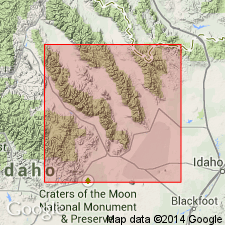
- Usage in publication:
-
- Gallagher Peak Sandstone Member*
- Modifications:
-
- Named
- Dominant lithology:
-
- Sandstone
- AAPG geologic province:
-
- Snake River basin
Summary:
Pg. 28-29, figs. 1-4, 6. Gallagher Peak Sandstone Member, middle member of Snaky Canyon Formation (new). Present in southern Lost River Range-Arco Hills, southern Lemhi Range, and southern Beaverhead Mountains, south-central Idaho. Consists mostly of medium-gray and light-brownish-gray, very fine-grained, thin-bedded, calcareous, quartzose sandstone; locally fossiliferous at or near base. Thickness at type 195 feet (59 m). Gradationally underlies Juniper Gulch Member and overlies Bloom Member, all of Snaky Canyon Formation (all new). Age is considered Late Pennsylvanian (Missourian), based on fossils (brachiopods, pelecypods, solitary and colonial corals, bryozoans, fusulinids). Authors propose an arbitrary northern limit for the Arco Hills, Bluebird Mountain, and Snaky Canyon Formations at about Lat. 44 deg. 30 min. N.; volcanic rocks along northeast margin of Snake River Plain provide natural southern limit. Report includes correlation chart, measured sections, fossil list, geologic sketch map.
Type section (=type section of Juniper Gulch Member); incomplete, beds overturned: about halfway between Snaky Canyon and Juniper Gulch, in sec. 21, T. 9 N., R. 32 E., [in vicinity of Lat. 44 deg. 05 min. 26 sec. N., Long. 112 deg. 42 min. 22 sec. W.], Snaky Canyon 7.5-min quadrangle, [Targhee National Forest], Clark Co., ID. Named from exposures on Gallagher Peak, in secs. 29 and 30 (unsurveyed), T. 10 N., R. 31 E., [Lat. 44 deg. 10 min. 02 sec. N., Long. 112 deg. 47 min. 22 sec. W.], Cooper Mountain 7.5-min quadrangle, [Targhee National Forest], Clark Co., ID. [Lat./Long. coords. from USGS GNIS database and ACME Mapper 2.0, accessed on Darwin's 200th birthday, 2009.]
[Misprint: type section given in US geologic names lexicon (USGS Bull. 1564, p. 64) is incorrect.]
Source: Publication; US geologic names lexicon (USGS Bull. 1564, p. 63-64); Changes in stratigraphic nomenclature, 1979 (USGS Bull. 1502-A, p. A30).
For more information, please contact Nancy Stamm, Geologic Names Committee Secretary.
Asterisk (*) indicates published by U.S. Geological Survey authors.
"No current usage" (†) implies that a name has been abandoned or has fallen into disuse. Former usage and, if known, replacement name given in parentheses ( ).
Slash (/) indicates name conflicts with nomenclatural guidelines (CSN, 1933; ACSN, 1961, 1970; NACSN, 1983, 2005, 2021). May be explained within brackets ([ ]).

